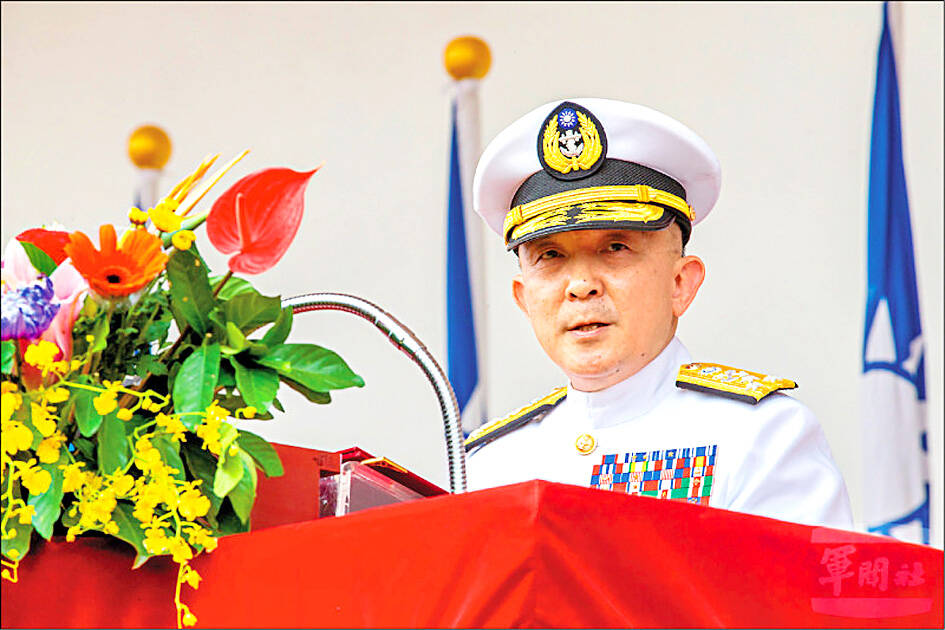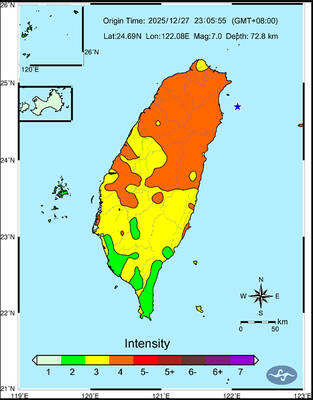China’s authoritarian expansionism threatens not only Taiwan, but the rules-based international order, the navy said yesterday, after its top commander said in an interview that the Chinese People’s Liberation Army (PLA) could blockade the nation at will.
The object of Beijing’s expansionist activities is not limited to Taiwan and its use of pressure is not confined to specific political groups or people, the navy said in a statement.
China utilizes a mixture of cognitive warfare and “gray zone” military activities to pressure Taiwan, the navy said, adding that PLA sea and air forces are compressing the nation’s defensive depth.

Photo courtesy of the Military News Agency
The navy continues to counter Chinese actions by using its forces flexibly and integrating reconnaissance assets to ensure constant surveillance and quick reactions, it said.
The military closely watches the development of new tactics by the Chinese and takes prompt countermeasures to defend the nation’s sovereign waters, it said.
Navy Commander Admiral Tang Hua (唐華) on Thursday said in an interview with The Economist that the PLA is enacting an “anaconda strategy” to subdue Taiwan and that the nation’s armed forces are being stretched thin.
The Chinese military is “slowly, but surely” increasing its presence around Taiwan proper, he was quoted by the magazine as saying.
“They are ready to blockade Taiwan at any time they want,” he said.
PLA air incursions across the Taiwan Strait’s median line surged five times from 36 in January to 193 last month, and Chinese ships operating near Taiwanese waters have doubled from 142 to 282 during the same period, he said.
Chinese ships have moved closer to Taiwan and sail along the nation’s contiguous zone, or 24 nautical miles (44km) from shore, patrolling for days at a time, Tang said.
Citing Taiwanese analysts Ma Cheng-kun (馬振坤) and Tristan Tan, The Economist said the Taiwanese navy is deploying 25 percent to 50 percent of its combat strength to match PLA patrols.
“They give you extreme pressure, pressure, pressure. They’re trying to exhaust you,” Tang said, adding that a government audit found that more than half of Taiwanese principal combatants have fallen behind schedule on maintenance.
Most Taiwanese are unaware of PLA patrols’ proximity and regularity, as government updates on Chinese military activities do not identify warship types, their designation or the duration of their presence, Tang said.
The government could be worried that disclosure could harm Taiwanese morale or the economy, he was paraphrased as saying.
The navy is focused on avoiding confrontation as the PLA inches closer to the nation, because Beijing’s goal is to “force Taiwan to make mistakes,” Tang said, adding that mishaps could serve as “excuses” for launching a blockade.
The military this year issued new rules of engagement that legally and morally define the justifiable use of force, he said.
“We restrain our guys not to provoke or escalate,” he added.
The PLA has 10 times as many destroyers as Taiwan and twice as many frigates, The Economist said.

A magnitude 7.0 earthquake struck off Yilan at 11:05pm yesterday, the Central Weather Administration (CWA) said. The epicenter was located at sea, about 32.3km east of Yilan County Hall, at a depth of 72.8km, CWA data showed There were no immediate reports of damage. The intensity of the quake, which gauges the actual effect of a seismic event, measured 4 in Yilan County area on Taiwan’s seven-tier intensity scale, the data showed. It measured 4 in other parts of eastern, northern and central Taiwan as well as Tainan, and 3 in Kaohsiung and Pingtung County, and 2 in Lienchiang and Penghu counties and 1

FOREIGN INTERFERENCE: Beijing would likely intensify public opinion warfare in next year’s local elections to prevent Lai from getting re-elected, the ‘Yomiuri Shimbun’ said Internal documents from a Chinese artificial intelligence (AI) company indicated that China has been using the technology to intervene in foreign elections, including propaganda targeting Taiwan’s local elections next year and presidential elections in 2028, a Japanese newspaper reported yesterday. The Institute of National Security of Vanderbilt University obtained nearly 400 pages of documents from GoLaxy, a company with ties to the Chinese government, and found evidence that it had apparently deployed sophisticated, AI-driven propaganda campaigns in Hong Kong and Taiwan to shape public opinion, the Yomiuri Shimbun reported. GoLaxy provides insights, situation analysis and public opinion-shaping technology by conducting network surveillance

‘POLITICAL GAME’: DPP lawmakers said the motion would not meet the legislative threshold needed, and accused the KMT and the TPP of trivializing the Constitution The Legislative Yuan yesterday approved a motion to initiate impeachment proceedings against President William Lai (賴清德), saying he had undermined Taiwan’s constitutional order and democracy. The motion was approved 61-50 by lawmakers from the main opposition Chinese Nationalist Party (KMT) and the smaller Taiwan People’s Party (TPP), who together hold a legislative majority. Under the motion, a roll call vote for impeachment would be held on May 19 next year, after various hearings are held and Lai is given the chance to defend himself. The move came after Lai on Monday last week did not promulgate an amendment passed by the legislature that

AFTERMATH: The Taipei City Government said it received 39 minor incident reports including gas leaks, water leaks and outages, and a damaged traffic signal A magnitude 7.0 earthquake struck off Taiwan’s northeastern coast late on Saturday, producing only two major aftershocks as of yesterday noon, the Central Weather Administration (CWA) said. The limited aftershocks contrast with last year’s major earthquake in Hualien County, as Saturday’s earthquake occurred at a greater depth in a subduction zone. Saturday’s earthquake struck at 11:05pm, with its hypocenter about 32.3km east of Yilan County Hall, at a depth of 72.8km. Shaking was felt in 17 administrative regions north of Tainan and in eastern Taiwan, reaching intensity level 4 on Taiwan’s seven-tier seismic scale, the CWA said. In Hualien, the